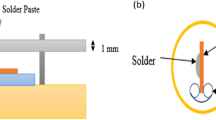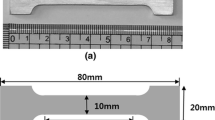Abstract
Recently, the use of Sn–Pb eutectic solder has been prohibited by restriction of the use of hazardous substances (RoHS), since Pb may have a bad influence on human and the environment. Instead, Tin–Silver–Copper (Sn–Ag–Cu) system is adopted as the lead free solder. However, the melting temperature of Sn–Ag–Cu is higher than that of Sn–Pb, which may induce damages in the electronic packages. To solve this problem, Sn nanoparticles were fabricated in this study. Morphology observation and component analysis of Sn nanoparticles were carried out by field emission scanning electron microscopy (FE-SEM), transmission electron microscopy (TEM) and energy dispersive X-ray (EDX) spectroscopy, respectively. The melting temperature of Sn nanoparticles was measured by differential scanning calorimeter (DSC822e). The lowest melting temperature of the present Sn nanoparticles is 440 K, which is approximately 65 K lower than that of the bulk Sn.











Similar content being viewed by others
References
Andersson C, Lai Z, Liu J, Jiang H, Yu Y (2005) Comparison of isothermal mechanical fatigue properties of lead-free solder joints and bulk solders. Mater Sci Eng A 394:20–27. doi:10.1016/j.msea.2004.10.043
Buffat Ph, Borel J-P (1976) Size effect on the melting temperature of gold particles. Phys Rev A 13:2287–2298. doi:10.1103/PhysRevA.13.2287
Carroll MA, Warwick ME (1987) Surface tension of some Sn–Pb alloys: part 1 effect of Bi, Sb, P, Ag, and Cu on 60Sn–40Pb solder. Mater Sci Tech 3:1040–1045. doi:10.1179/026708387790329423
Koppes JP et al (2012) Utilizing the thermodynamic nanoparticle size effects for low temperature Pb-free solder. Mater Sci Eng B 177:197–204. doi:10.1016/j.mseb.2011.12.019
Lai SL, Guo JY, Petrova V, Ramanath G, Allen LH (1996) Size-dependent melting properties of small tin particles. Phys Rev Lett 77:99–102. doi:10.1103/PhysRevLett.77.99
Wronski CRM (1967) The size dependence of the melting point of small particles of tin. Brit J Appl Phys 18:1731–1737. doi:10.1088/0508-3443/18/12/308
Wu C, Mosher BP, Zeng T (2008) Powder-based nanoparticles fabrication technique in solution phase. Powder Tech 188:166–169. doi:10.1016/j.powtec.2008.04.038
Zou CD, Gao YL, Yang B, Zhai QJ (2010) Size-dependent melting properties of Sn nanoparticles by chemical reduction synthesis. Trans Nonferrous Met Soc China 20:248–253. doi:10.1016/S1003-6326(09)60130-8
Acknowledgments
This work was supported by the Japan Society for the Promotion of Science under a Grant-in-Aid for Scientific Research (A) 23246024.
Author information
Authors and Affiliations
Corresponding author
Rights and permissions
About this article
Cite this article
Ju, Y., Tasaka, T., Yamauchi, H. et al. Synthesis of Sn nanoparticles and their size effect on the melting point. Microsyst Technol 21, 1849–1854 (2015). https://doi.org/10.1007/s00542-014-2397-z
Received:
Accepted:
Published:
Issue Date:
DOI: https://doi.org/10.1007/s00542-014-2397-z




